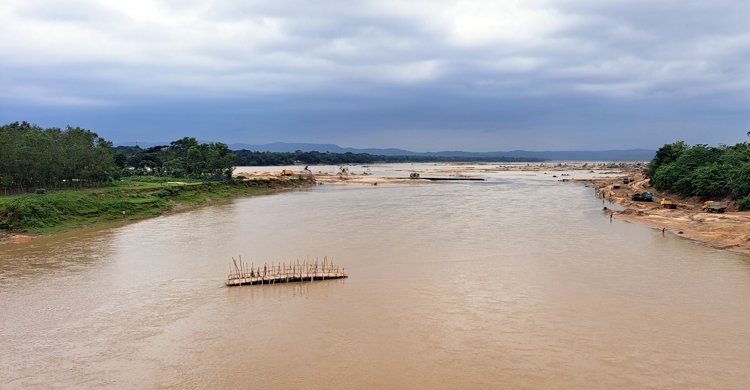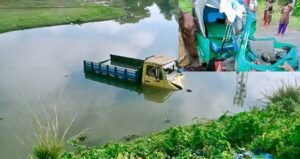As Sunamganj Haor runs dry, livelihoods hang in the balance
Published: 03 August 2025, 4:10:55

A severe water shortage in Sunamganj’s Haor (wetland) region has led to a growing crisis in both agriculture and fisheries. The lack of water is destroying fish habitats and disrupting breeding cycles.
Farmers are struggling with irrigation, causing a drop in crop production. Consequently, livelihoods in Haor communities are now at risk.
Mamun Howlader, executive engineer of the Sunamganj Water Development Board (WDB), said: “This year, the lack of monsoon rain has had a significant impact on the Haor ecosystem.”
Typically, the Haor remains submerged in the monsoon, making boats essential. But in the Bengali season of Hemanta, the waters recede and roads reappear.
This year, however, the shortage of rainwater has disrupted boat travel, making transportation difficult for residents.
Farmers and experts point to several contributing factors, including climate change, upstream water regulation of Indian rivers, construction of barrages, encroachment of rivers, unplanned embankments, and lack of river dredging.
Environmentalists and Haor advocates are calling for an end to destructive activities that harm nature and the ecosystem.
FARMERS, FISHERMAN FRUSTRATED
Residents say their lives depend almost entirely on agriculture and fishing — both now under threat due to reduced water levels. Crop failures and a decline in fish populations are becoming serious concerns.
The shortage of water is already affecting local fish markets. Unlike previous years, when Haor markets were full of native fish, fish supply is low this year and prices have skyrocketed.
Alkash Mia, a fisherman from Noagaon village in Gourarang Union, said: “With less water in the Haor, it’s harder to fish. We can’t even cast nets in usual spots due to low water levels. Fish are much fewer this year.”
Soaeb Mia, a trader in Sunamganj’s fish market, added: “At this time in previous years, the Haor was full of native fish. This year, fish stock is less than half of what it was. Prices have doubled, but even then, local fish are hard to find. Fish catch in government-leased water bodies will also be low this season.”
Obaidur Rahman Kubad, a farmer from Boglakhara village in Shantiganj Upazila, said: “If the water keeps dropping like this, it’ll be difficult to plant Boro rice. Even preparing seedbeds will be hard. And even if we manage to plant, irrigation water won’t be available. Our only rice crop will be at risk.”
DATA HIGHLIGHTS CRISIS
Last year, water levels at the Surma River’s Sunamganj point were 6.37m on Jul 29, 6.36m on Jul 30, and 6.30m on Jul 31, according to WDB official Mamun.
This year, on the same dates, the water levels were significantly lower at 5.84m, 5.81m, and 5.83m respectively.
“Last year, in July, water in Surma, Old Surma, and Jadukata rivers stayed above danger levels for most of the time. This year, we are seeing the opposite trend.”
IMPACT OF CLIMATE AND HUMAN ACTIVITIES
Officials say the lack of rainfall in both upstream and downstream areas is a key factor. There was only a brief increase in water levels in June due to some rain. Since then, water levels have continued to fall. Haor roads and grassy areas are now visible, and in some places, livestock are grazing in areas that are usually underwater.
Residents say that water typically enters the Haor from mountain streams and rivers, as well as from rainfall. But this year, there’s been inadequate rainfall and no upstream flow. The Surma River, the region’s main waterway, is low, as are other rivers.
Without the influx of fresh monsoon water, fish reproduction, movement, and aquatic biodiversity are all negatively affected.
Experts warn that Haors may face flash floods and describe the situation as a grave threat to the region’s ecology and traditional lifestyle.
Abdul Hai Chowdhury, director of Associates for Innovative Research and Development (AIRD), said: “A dry Haor at this time of the year is unimaginable. This is not just a seasonal variation, it’s an indication of a deep environmental crisis.”
He attributes the problem to climate change, upstream water control, blocked river flows, lack of dredging, and poorly planned embankments. Without urgent action, biodiversity, livelihoods, and the wellbeing of Haor communities are at risk.
“This situation stems from interconnected causes. We need regional diplomacy on transboundary water management, internal river reforms, and climate-resilient infrastructure,” he added.





